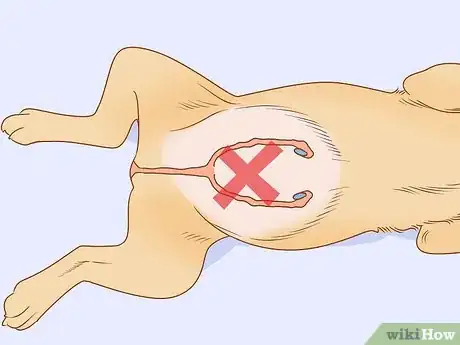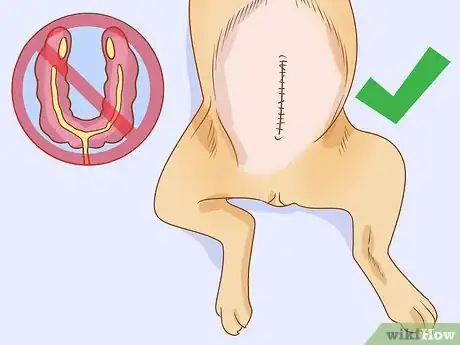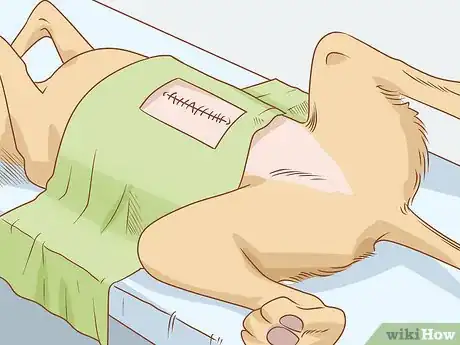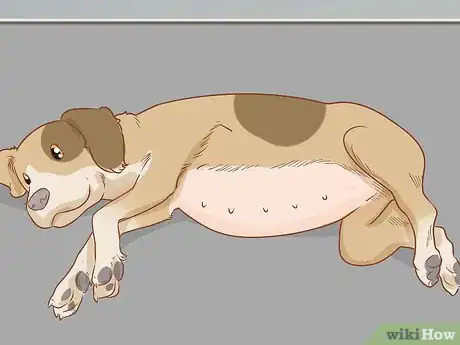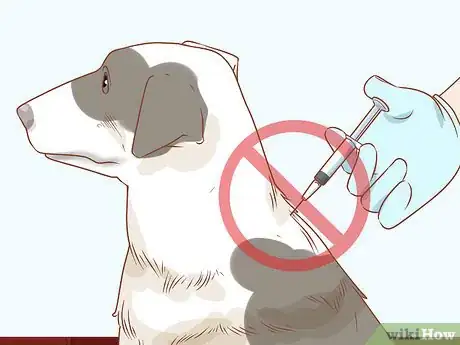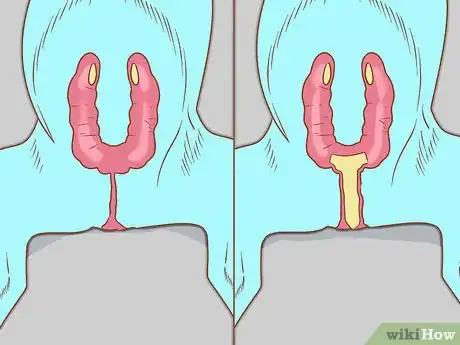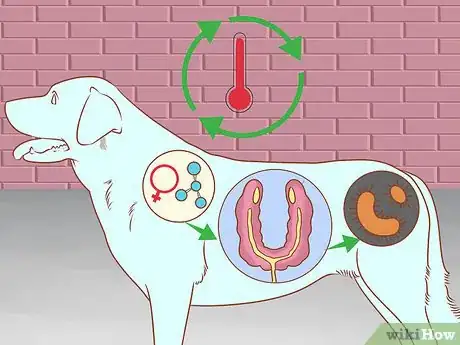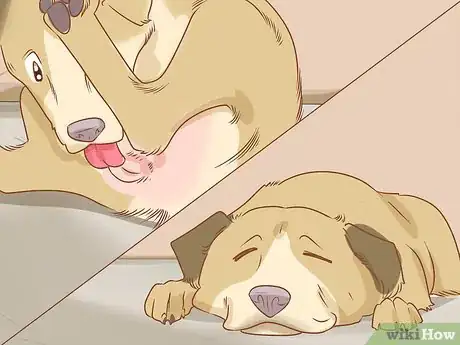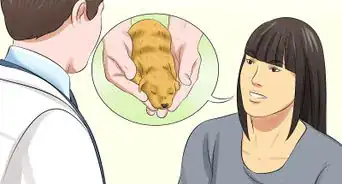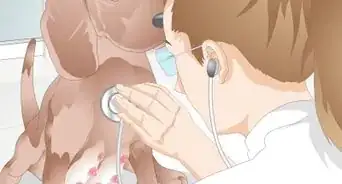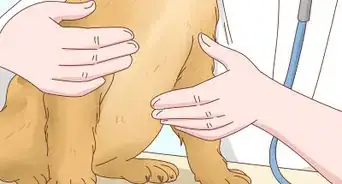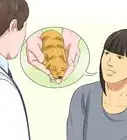This article was co-authored by Lauren Baker, DVM, PhD. Dr. Lauren Baker is a Veterinarian and Assistant Scientist at the University of Wisconsin-Madison. With over 10 years in veterinary medicine, she specializes in the concept of “one health,” which uses insights from veterinary medicine to help human medical research. She holds a Ph.D. in Comparative Biomedical Sciences, a Doctor of Veterinary Medicine, an MS in Comparative Biomedical Sciences, and a Bachelor’s degree in Psychology from the University of Wisconsin-Madison.
This article has been viewed 41,231 times.
Pyometra is an infection of the uterus that occurs in female dogs who haven't been spayed. It is a serious, life-threatening condition which usually requires surgical treatment. Preventing pyometra will save your dog from unnecessary pain, while it saves you from the emotional and financial stress of treating your dog. The only way to ensure the prevention of pyometra is to have your pet spayed.
Steps
Spaying Your Dog
-
1Determine how you will pay for the surgery. Some spaying surgeries may be expensive, but there are options if you can't afford it. Contact local shelters or humane societies to find out if there are low-cost options in your area. Many shelters or animal groups will perform the surgery at a reduced rate.[1]
- Talk to your vet about payment plans. Many vets will work something out with you so you can get this important surgery.
-
2Spay your dog. The only guaranteed way of preventing pyometra is to spay your dog. Spaying is the removal of the dog's reproductive organs. During the surgery, the surgeon puts the dog under anesthesia and opens the dog's abdomen.
- There is a small risk of hemorrhage during the operation because the surgeon has to tie off major arteries to the ovaries and the uterus.
Advertisement -
3Spay the dog as early as possible. Spaying your dog has numerous health benefits. Most important, it removes the risk of pyometra since she no longer has a womb to become infected. If performed before her second season, there is also a protective effect against mammary cancer in later life. The younger you spay your female dog, the more health benefits she will have.[2]
- A female dog can be spayed starting at several months old, and then at any point throughout her life. Very old dogs may not be the best candidates for the surgery, as they often have health problems that can make surgery more dangerous.
- Your vet may recommend extra blood work and other diagnostic tests to make sure your dog is healthy enough for the surgery.
-
4Schedule the surgery at the right time. A female dog usually has two heat cycles a year, and each is a huge hormonal event. Near the beginning, the blood supply to the uterus increases, and then the blood supply tapers off after the season. The ideal time to spay the dog is about two months after the end of the previous cycle up to around one month before the start of the next one.[3]
- The increased blood supply to the uterus makes the tissue more susceptible to tearing with normal surgical handling, causing an increased risk of serious hemorrhage.
Trying Other Prevention Methods
-
1Breed your non-spayed dog. If you don't want to spay your dog because you want to breed her, you can reduce the risk of pyometra by having her get pregnant multiple times. Plan out multiple sequential breedings, and then have her spayed when you are finished breeding her.
- If you are not an experienced breeder, consider your motivations for breeding your dog instead of spaying her. If you want to breed the dog, get in touch with experienced breeders to help you with breeding.
- Think about what you are going to do with the puppies. Be prepared to either sell the puppies or give them away.
- Breeding dogs can be expensive. You have to care for the mother dog and provide vet care for the puppies.
-
2Consider the risks associated with breeding. Breeding your dog only prevent pyometra if she becomes pregnant. Even then, there are rare cases that may let pyometra develop. Monitor your dog carefully after breeding to confirm that she is pregnant. If she is not, she is still susceptible to pyometra.
-
3Avoid using hormone injections to prevent the disease. Hormone injections are sometimes used to suppress heats in intact females. They are also used to treat certain conditions. Injecting intact females with estrogen or progesterone drugs can slightly increase the risk of a dog getting pyometra.[4]
- Don't give your dog hormone injections unless they are needed for a medical reason.
Learning About the Causes of Pyometra
-
1Know the difference between open and closed pyometra. Pyometra is a serious, potentially life-threatening condition that takes two forms: open and closed. The basic difference is that in open pyometra the cervix is open and drains, while in closed pyometra the cervix is shut the pus does not drain and the uterus may rupture.[5]
- The uterus can still rupture with open pyometra if the pus builds up before it can drain.
-
2Identify the causes of pyometra. Pyometra is most likely to occur around four to eight weeks after the end of the heat cycle, although it can occur at any stage of a female dog's reproductive cycle. The condition is caused by the influence of hormones, such as primarily progesterone, on the lining of the uterus.
- Increased hormones leads to thickening of the uterine wall, and the rise in gland secretions leads to a lowered immune system. These conditions cause an increased risk of bacterial infection.
- Older dogs, over the age of six years, are more likely to suffer from pyometra. However, occasionally a young dog is unfortunate and gets pyometra after her first or second season.
-
3Recognize the signs and symptoms of pyometra. The signs of pyometra indicate that the dog doesn't feel well. The dog may drink excessively, urinate more frequently, or vomit. She may also have a poor appetite and lethargy.
- If she has open pyometra, she may spend a lot of time licking her vulva and you might see pus staining her bedding.
- In extreme cases of closed pyometra, her belly may become swollen.
- Take your dog to the vet immediately if you notice these symptoms.
Warnings
- If you think our dog may have pyometra, seek out veterinary care immediately. Pyometra is a serious medical condition that will turn deadly if left untreated.⧼thumbs_response⧽
References
- ↑ http://www.humanesociety.org/issues/pet_overpopulation/tips/afford_spay_neuter.html
- ↑ https://www.mspca.org/angell_services/pyometra-what-is-it-and-why-does-it-happen/
- ↑ https://www.aspca.org/pet-care/general-pet-care/spayneuter-your-pet
- ↑ https://vcahospitals.com/know-your-pet/pyometra-in-dogs
- ↑ https://vcahospitals.com/know-your-pet/pyometra-in-dogs
About This Article
The best way to prevent pyometra in your dog is to get it spayed as early as possible. If you don't want to spay your dog right away, talk to your veterinarian about how many times you should breed it before spaying to reduce the risk of pyometra. Additionally, try to avoid using hormone injections to suppress heat cycles in your dog, since the hormones can increase its risk of getting pyometra. For advice from our Veterinary co-author on how to identify the symptoms of pyometra, read on!

